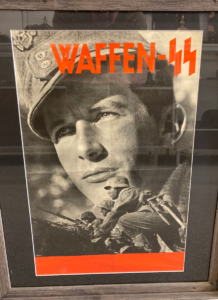This week I would like to continue the theme of the items that I search for as well as discuss items that I do buy, but are difficult merchandise for resale.
WW2 Dress Military Uniforms and Their Color Changes
First, I would like to discuss Dress Military Uniforms and some of the challenges they present. The challenge goes all the way back until the end of WWII. At the conclusion of the war, millions of servicemen were discharged and someone decided that each service member would be issued a new uniform for their return home. These uniforms issued at the Demobilization Centers included:
- Rank Insignia Patches
- Unit Insignia Patches
- Ribbons
- Badges
One can get an idea as to the scale and cost of this effort. Some service members, if they were traveling back to a cold climate, were even issued overcoats. These uniforms were worn for several days as they rode the trains home. Around seven million WW2 dress military uniforms were then hung in closets and attics, where they were slowly tortured by insects and the elements. One of my good friends, COL (Ret) Patrick Cassidy shared the story of his father a NCO in the 17th Airborne Division. Pat’s dad had his four-pocket jacket hand-tailored in England for a custom fit. When he returned to the states to be discharged, the officials demanded that he turn in the uniform for an ill-fitting Eisenhower “Ike” short-waisted jacket. He was very unhappy with the entire process. To those of you that ever wore this jacket, it is safe to say they are not the most attractive attire for all body types. They looked good on tall and thin Soldiers, but not so good on everyone else. Now fast forward 70 years to understand why most of these jackets today sell for a criminally low $10. That is now less than the current cost of a Big Mac value meal! The old economic law of supply and demand remains in effect some 70 years later. One can also imagine how incredulous this price seems to those families selling these items.
After WW2, the complexities of dress uniforms continued to increase. In 1947, the Air Force became a separate service and created millions of new uniforms in blue wool. In 1955, the Army dropped the olive drab (OD) color and the “Ike” jacket style in favor of a new Olive Green (OG), four pocket “Business Suit” style jacket. They also changed the color of leather boots and belts from brown to black. Don’t forget that these uniform changes bring new colors of shirts, ties, belts, and trousers. Changes like these generates millions of all kinds of military surplus items that will be absorbed into the civilian economy.

A good example of one of these changes were the change in the border color from the WW2 and 1950’s OD to the post 1955 OG. The change was made because the lighter shade OD clashed with the new green uniform. The first patch pictured above has the later OG border color compared with the lighter OD borders. Remember for decades we had four different services: Army, Navy, Air Force, and Coast Guard. Furthermore, we recently added a fifth service, the Space Force, and you get an idea as to the magnitude and complexity of dress uniforms. Unless a Veteran maintains a service uniform, the ability of his family to put one together for his funeral is next to impossible.
Framed Collections
Another difficult merchandise item to work are frames. There are several reasons that contribute to this challenge. First the high cost involved in framing historical photos, prints and posters is normally many times greater than the value of the item being displayed. Frames are large fragile items that are difficult and expensive to ship. Many collectors do not want to pay the shipping costs, so this limits the potential customer base.

Most collection rooms are small and wall space is at a premium, so the subject matter framed is critical to the theme of the collection. I recently purchased this Waffen SS Recruitment Poster realizing that its cost limits its appeal to potential collectors. The other issue with frames comes when pins, patches and other small collectible items are framed. The value of these items are in the individual pieces and not in the expensive frames that houses them. It hurts my heart to tear up these frames to sell the items separately.
If you have any historical military uniforms or a unique, framed collection, reach out to us at Military Collector Services! With several decades as a military collector, we can evaluate the market’s interest of your military item. As long as the item doesn’t belong to one of the categories of items Military Collector Services doesn’t buy, we would love to take a look at your military collection!
